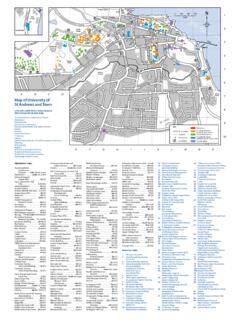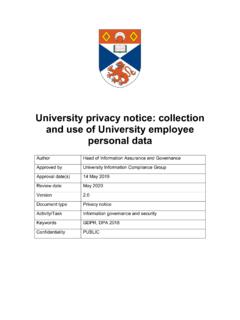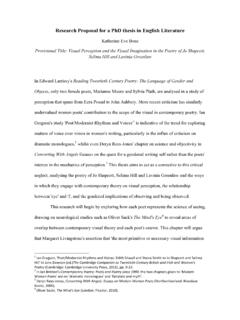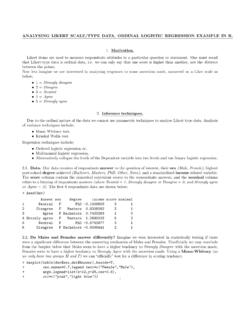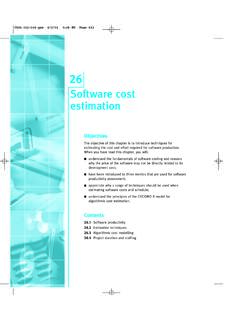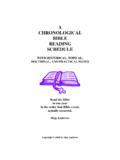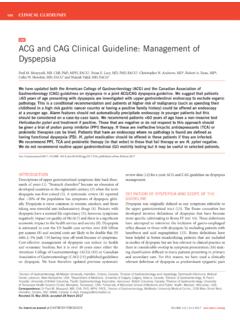Transcription of Quantum Optics - University of St Andrews
1 Light-Matter Interactionsand Quantum ~jmjk2/qoContentsContentsiiiIntroduction v1 Quantisation of Revision: Lagrangian for electromagnetism .. Eliminating redundant variables .. Canonical quantisation; photon modes .. Approximations of light-matter coupling .. Further reading ..72 Quantum electrodynamics in other Freedom of choice of gauge and classical equations .. Transformation to the electric dipole gauge .. Electric dipole gauge for semiclassical problems .. Pitfalls of perturbation .. Further reading ..183 Jaynes Cummings Semiclassical limit .. Single mode Quantum model .. Many mode Quantum model irreversible decay .. Further properties of collapse and revival ..274 Density matrices for 2 level Density matrix equation for relaxation of two-level system.
2 Dephasing in addition to relaxation .. Power broadening of absorption .. Further reading ..375 Resonance Spectrum of emission into a reservoir .. Quantum regression theorem .. Resonance fluorescence spectrum .. Further reading ..446 Quantum stochastic Quantum jump formalism .. Heisenberg-Langevin equations .. Fluctuation dissipation theorem .. Further reading ..527 Cavity Quantum The Purcell effect in a 1D model cavity .. Weak to strong coupling via density matrices .. Examples of Cavity QED systems .. Further reading ..678 Simple density matrix equation for collective emission .. Beyond the simple model .. Further reading ..789 The Dicke Phase transitions, spontaneous superradiance.
3 No-go theorem: no vacuum instability .. Radiation in a box; restoring the phase transition .. Dynamic superradiance .. Further Reading ..8610 Lasers and Density matrix equations for a micromaser and a laser .. Laser rate equations .. Laser Linewidth .. Further reading ..9611 More on Density matrix equation .. Spontaneous emission, noise, and parameter .. Single atom lasers .. Further reading .. 11212 Three levels, and coherent Semiclassical introduction .. Coherent evolution alone; why does EIT occur .. Dark state polaritons .. Further reading .. 120 Bibliography123 IntroductionThe titlequantum opticscovers a large range of possible courses, and sothis introduction intends to explain what this course does and does not aimto provide.
4 Regarding the negatives, there are several things this coursedeliberately avoids: It is not a course on Quantum information theory. Some basic notionsof coherent states and entanglement will be assumed, but will not bethe focus. It is not a course on relativistic gauge field theories; the majorityof solid state physics does not require covariant descriptions, and soit is generally not worth paying the price in complexity of using amanifestly covariant formulation. As far as possible, it is not a course on semiclassical at times radiation will be treated classically, this will generallybe for comparison to a full Quantum treatment, or where such anapproximation is valid (for at least part of the radiation).Regarding the positive aims of this course, they are: to discuss how tomodel the Quantum behaviour of coupled light and matter; to introducesome simple models that can be used to describe such systems; to dis-cuss methods for open Quantum systems that arise naturally in the contextof coupled light and matter; and to discuss some of the more interestingphenomena which may arise for matter coupled to light.
5 Semiclassical be-haviour will be discussed in some sections, both because an understandingof semiclassical behaviour ( classical radiation coupled to Quantum me-chanical matter) is useful to motivate what phenomena might be expected;and also as comparison to the semiclassical case is important to see whatnew physics arises from quantised kind of Quantum optical systems discussed will generally consistof one or many few-level atoms coupled to one quantised radiation of such systems need not involve excitations of real atoms, butcan instead be artificial atoms, well defined Quantum systems with dis-crete level spectra which couple to the electromagnetic field. Such conceptstherefore apply to a wide variety of systems, and a variety of character-istic energies of electromagnetic radiation.
6 Systems currently studied ex-perimentally include: real atomic transitions coupled to optical cavities[1];vviINTRODUCTIONJ osephson junctions in microwave cavities (waveguides terminated by re-flecting boundaries)[2, 3]; Rydberg atoms (atoms with very high princi-ple Quantum numbers, hence small differences of energy levels) in GHzcavities[4]; and solid state excitations, excitons or trions localised inquantum dots, coupled to a variety of optical frequency cavities, includ-ing simple dielectric contrast cavities, photonic band gap materials, andwhispering gallery modes in disks[5].These different systems provide different opportunities for control andmeasurement; in some cases one can probe the atomic state, in some casesthe radiation state.
7 To describe experimental behaviour, one is in gen-eral interested in calculating a response function, relating the expectedoutcome to the applied input. However, to understand the predicted be-haviour, it is often clearer to consider the evolution of Quantum mechanicalstate; thus, both response functions and wavefunctions will be such, the lectures will switch between Heisenberg and Schr odinger pic-tures frequently according to which is most appropriate. When consideringopen Quantum systems, a variety of different approaches; density matrixequations, Heisenberg-Langevin equations and their semiclassical approxi-mations, again corresponding to both Schr odinger and Heisenberg main part of this course will start with the simplest case of a singletwo-level atom, and discuss this in the context of one or many quantisedradiation modes.
8 The techniques developed in this will then be appliedto the problem of many two-level atoms, leading to collective effects. Thetechniques of open Quantum systems will also be applied to describing las-ing, focussing on the more Quantum examples of micromasers and singleatom lasers. The end of the course will consider atoms beyond the two-levelapproximation, illustrating what new physics may arise. Separate to thismain discussion, the first two lectures stand alone in discusing where thesimple models of coupled light and matter used in the rest of the coursecome from, in terms of the quantised theory of 1 Quantisation ofelectromagnetism in theCoulomb gaugeOur aim is to write a theory of quantised radiation interacting with quan-tised matter fields. Such a theory, the Jaynes-Cummings model (seenext lecture) has an intuitive k ka kak+ i,k[ i zi+gi,k +iak+ ].
9 ( )The operatora kcreates a photon in the mode with wavevectork, and sothis Hamiltonian describes a process where a two-level system can changeits state with the associated emission or absorption of a photon. The term ka kakthen gives the total energy associated with occupation of the modewith energy k. While the rest of the course is dedicated to studying suchmodels of coupled light-matter system, this (and in part the next) lecturewill show the relation between such models and the classical electromag-netism of Maxwell s reach this destination, we will follow the route of canonical quan-tisation; our first aim is therefore to write a Lagrangian in terms of onlyrelevant variables. Relevant variables are those where both the variable andits time derivative appear in the Lagrangian; if the time derivative does notappear, then we cannot define the canonically conjugate momentum, andso cannot enforce canonical commutation relations.
10 The simplest way ofwriting the Lagrangian for electromagnetism contains irrelevant variables the electric scalar potential and gauge of the vector potentialA;that irrelevant variables exist is due to the gauge invariance of the we are not worried about preserving manifest Lorentz covariance,we are free to solve this problem in the simplest way eliminating theunnecessary 1. QUANTISATION OF Revision: Lagrangian for electromagnetismTo describe matter interacting with radiation, we wish to write a La-grangian whose equations of motion will reproduce Maxwell s and Lorentz sequations: B= 0J+ 0 0 E E= / 0( ) B= 0 E= B( )m r =q [E(r ) + r B(r )].( )Equations ( ) determine the structure of the fields, not their dynamics,and are immediately satisfied by definingB= AandE= A.
